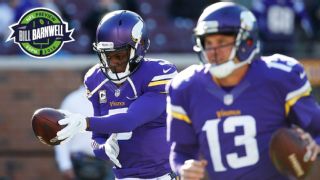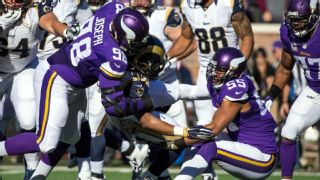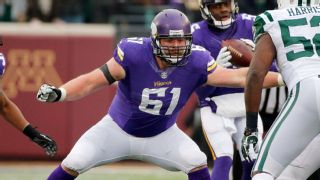For the second time this week, we're here to talk about a team's chances after losing its starting quarterback to a serious injury. After Tony Romo went down for the Cowboys earlier this weekend, Vikings quarterback Teddy Bridgewater suffered a serious knee injury in practice Tuesday. It speaks to the severity of the early reports surrounding the injury that the eventual diagnosis of a season-ending torn ACL and dislocated knee was seen as a lucky break for Minnesota.
It was Romo and the 2015 Cowboys who offered a perfect example of how a team can be felled quickly by an injury to their starting passer. Dallas went 12-4 during a banner 2014 campaign and started 2-0 last season, before Romo broke his collarbone. They then went 0-7, won Romo's first game back, and after Romo broke his collarbone for a second time, went 1-5 the rest of the way. There's at least a chance things go pear-shaped in the same way for the Vikings, too.
My suspicion, though, is that the Vikings aren't this year's version of the Cowboys. It's hard to argue that they will be better without their starting quarterback, and I won't claim they will be. But there are reasons to believe the Vikings could be competitive in 2016 and not suffer the fate of last year's Cowboys. Let's look at the post-Teddy roster and identify why the Vikings and their fans should still hold out hope:
This defense could be really good ... and better than last year.
Some might make the case that the Vikings were already great on defense last year by using traditional numbers. Mike Zimmer's defense finished the year fifth in points allowed, but some of that comes out in the contextual wash. Minnesota faced only 170 meaningful possessions, the fourth-lowest total in the league, and its defense started its average drive with the fifth-best starting field position in football.

As a result, the Vikings finished the season 14th in DVOA, just below the Colts, who aren't exactly drawing attention as an up-and-coming defense. In a way, though, finishing 14th is better for their chances of improving on defense this season than finishing fifth, right? Minnesota has been steadily improving under Zimmer, too. After inheriting a defense that finished 27th in DVOA before his arrival in 2013, Zimmer's charges finished 23rd as he reshaped the unit before jumping to 14th last season.
It's a young defense in a lot of spots, too, even if the numbers are skewed a bit by some older starters. The Football Outsiders Almanac 2016 notes that the average Vikings defender in for a given snap last year was 27.5 years old, which was the fourth-oldest in the league. But those numbers include huge workloads with more than 80 percent of the defensive snaps for defensive end Brian Robison, who was 32 last year, and cornerback Terence Newman, who was 37. Outside linebacker Chad Greenway, also 32 last year, played 58.8 percent of the defensive snaps.
Robison and Newman should shift further into defensive rotations this year and lose snaps to a pair of second-year defenders, defensive end Danielle Hunter and 2015 first-round pick Trae Waynes. Hunter, who had six sacks last year, is likely to be the team's starting end across from Everson Griffen by the end of the year. Waynes struggled at times as a rookie, but even future superstar cornerbacks often struggle as rookies. With Waynes and 2016 second-rounder Mackensie Alexander in reserve, the Vikings have options if Newman finally feels the effects of Father Time.
Elsewhere, the Vikings have five above-average starters who are all first- or second-round picks from their last five draft classes, paced by star safety Harrison Smith. Smith and versatile linebacker Anthony Barr are already Pro Bowlers, and the other three are each capable of making another leap forward this year. Cornerback Xavier Rhodes has improved dramatically during his time in the league and needs only to cut down on his penalties to justify Pro Bowl consideration. Defensive tackle Sharrif Floyd might already be there if he could make it through a 16-game season, and middle linebacker Eric Kendricks shored up the team's perennial weak spot at middle linebacker after taking over as a starter in midseason. These guys are all already good and young enough to have a shot at becoming great.
More than anything, there's just so much talent on this defense that there are bound to be guys who make plays on a weekly basis. Griffen had 10.5 sacks last year, which isn't bad by any means, but his 30 quarterback knockdowns suggest that he's likely to improve the sack total in 2016 if he stays healthy. Reserve interior pass-rusher Tom Johnson might be one of the most underrated players in all of football; for just over $2 million, the Vikings got 20 knockdowns out of Johnson last year, as many as the Dolphins got from Ndamukong Suh.

It's not a guarantee the Minnesota defense improves in 2016. It was the league's seventh-healthiest unit per Adjusted Games Lost last season and ranked second in red-zone defense in terms of points allowed per trip inside the 20. Both of those factors are incredibly important and incredibly unlikely to occur on an annual basis. Even if the Vikings do play worse in the red zone and struggle more with injuries, though, they're deep enough and talented enough on defense that a baseline level of play should get better. At the very least, there's a significant chance the Vikings are a better defense in 2016, which was unlikely for the Cowboys and their fluky league-leading takeaway rate this time last year.
They're the most run-heavy offense in the league ... and Adrian Peterson is still here.
In one sense, the Vikings needed less out of their quarterback than any other team. They attempted just 454 passes last year, the fewest in all of football and a whopping 117 attempts below the NFL average. All but seven of those passes came from Bridgewater. Only the Rams averaged fewer passing yards per game than Minnesota's 183.0 yards per contest.
This is a run-first football team. As I mentioned when writing about Bridgewater earlier this month, the Vikings ran the ball 66.5 percent of the time on first-and-10 when the game was within 14 points. That was the highest rate in football. A league-high 27.2 percent of Bridgewater's passes involved play-action. The Vikings pounded the ball as much as anybody in football and still finished eighth in DVOA, speaking to their rare combination of both volume and efficiency.
It's also not crazy to imagine the running game being even better in 2015. They will lose Bridgewater, who has been a surprisingly efficient runner on designed draws and scrambles, and it's always risky to believe that Peterson (or any back) will make it through a full 16-game season, as he did in 2015, without missing a week or two with injuries. The Vikings do have a wildly productive backup for Peterson in third-year man Jerick McKinnon, though, and were fourth in rushing DVOA in 2014 while Peterson sat on the exempt list for 15 of 16 games.
Instead, the Vikings could be better running the football because of an improved offensive line. Minnesota spent all of 2015 without two starters up front, losing center John Sullivan and right tackle Phil Loadholt to season-ending injuries. Sullivan and Loadholt are gone; Loadholt retired, and Sullivan was released Tuesday. Joe Berger excelled in Sullivan's absence at center, and Minnesota imported free agents Andre Smith and Alex Boone, both of whom have been excellent run blockers when healthy. Minnesota also got a piece of now-forgotten good news when H-back Rhett Ellison returned to practice last week after tearing his patella in January.

The Cowboys, meanwhile, couldn't have been as effective in 2015 as they were the previous year. They lost DeMarco Murray, who had produced a career year and stayed healthy for the first time as a pro in 2014. Their five starting offensive linemen started 75 of 80 games together in 2014, while guard Ronald Leary went down with a groin injury in the very first week of the season in 2015. He would have gotten his job back if it weren't for the presence of freakish rookie guard La'el Collins, whom the Cowboys were lucky to see fall into undrafted free agency, but the point about the line struggling to be quite as healthy still stands. Dallas also never really had a healthy Dez Bryant in 2015, which dramatically impacted the passing attack, independent of their quarterback situation.
The dropoff from Bridgewater to Shaun Hill isn't anywhere near as bad as the dropoff from Romo to Matt Cassel and Brandon Weeden.
While Romo threw only 435 passes in 2014, he was incredibly efficient and effective on those passes, leading the league in completion percentage, yards per attempt, passer rating and QBR. His replacements did not threaten to lead the league in anything, at least not anything good. Bryant's absence and limited ability didn't help matters, but going from Romo's MVP-caliber season to Cassel learning the playbook in midseason is about as big of a swing as you'll see at quarterback.
Bridgewater and Hill have different styles, and Bridgewater obviously has more long-term upside than a 36-year-old backup, but their level of production as pros hasn't been that different. Since throwing his first professional pass in 2007, Hill has posted a QBR of 45.6. Bridgewater posted a 62.7 figure last year and is at 59.9 so far as a pro. The difference between Romo in 2014 (a QBR of 83.6) and the various Dallas passers in 2015 (39.8) was much larger.
Let's put it in context another way. The pro-football-reference.com Index statistics adjust a quarterback's statistics for the era in which he was performing and scale them so that 100 is league-average. Since Hill threw that first pass in 2007, he has posted an era-adjusted passer rating (Rate+) of 101, right in line with Eli Manning and Jay Cutler. In terms of adjusted net yards per attempt (ANY/A+), which is probably the best single-number quarterback metric using raw statistics, Hill has posted a mark of 98. That's just below Joe Flacco (99) and good for 29th out of the 47 quarterbacks who have thrown 1,000 passes or more over that timeframe. Hill's era-adjusted career numbers aren't notably worse than Bridgewater's. In some cases, they're actually better. Take a look:
The problem, of course, is with aging curves. Bridgewater is 23 and was likely to continue improving with a young receiving corps and an improved offensive line. Hill is 36 and has just one season with meaningful action since the end of the 2010 season, when he was mediocre for the 2014 Rams and went 3-7 despite an excellent defense. That was with a porous offensive line and the infamously dull Brian Schottenheimer as offensive coordinator, though, and Hill should have more to work with as the regular in Minnesota this season.
Hill might actually fit into Norv Turner's scheme.
Again, in looking back at the Bridgewater piece from earlier this month, I noted how Turner has really built a scheme around his offense's strengths and weaknesses. His offensive line wasn't great, so Turner's running game was built more around timing and misdirection and slowing defenders down with threats of run-pass options from Bridgewater, who did an excellent job of handling the football before giving it to Peterson or attempting a pass.
The other notable tendency with the offense has been attacking deep. Bridgewater made excellent throws downfield here and there, but overall as a pro he hasn't been an effective deep passer in terms of efficiency. Turner has also accounted for that in his playcalling and doesn't have Bridgewater throw downfield very often, which is out of character for an offensive coordinator who loved to have Philip Rivers chuck the ball downfield in San Diego.
With Bridgewater out of the lineup, Turner will probably need to change his offense again. It will be impossible to rebuild the offense on the fly in the two weeks before the season starts, but with a healthier, more imposing offensive line, it wouldn't be a surprise to see him try to line up and overwhelm teams physically without resorting to the run-pass options. With Bridgewater out of the lineup, Turner might simplify his offense for Hill by removing those concepts from the playbook or going to them less frequently.
And it wouldn't be a surprise to see Turner take more shots downfield with Hill in the lineup. The Vikings will still be relying heavily on their running game and play-action, and that's where Turner will want to challenge safeties creeping up to the line of scrimmage with throws to Stefon Diggs and the rest of the Vikings' receiving corps. Hill, for what it's worth, has been a totally reasonable downfield attacker during his pro career. ESPN credits him for a QBR of 84.3 on throws 20 or more yards downfield as a pro, against a league-average of 84.6 over that same timeframe.
QBR tends to reward passers for their deep throws, because they're so dependent upon quarterback skill. If we use passer rating instead, Hill has posted an 88.6 mark against a league-average of 86.6. Of Hill's deep throws, 41.3 percent have been successful against a league-average rate of 41.6 percent. He's basically been a league-average downfield passer. If age hasn't sapped Hill's arm strength, that would be an upgrade for the Vikings, who could also be better at wide receiver this year, thanks to the draft and development.
The idea of being average isn't exciting, but for a team fresh off losing its star passer in a league in which quarterbacks mean everything, maybe it does matter. If Hill is the 35th-best quarterback in the league right now in a vacuum, that would be a very comfortable landing spot, given how far teams can fall when they lose their starting quarterback. The Vikings are a team built wisely upon solid coaching and above-average depth, trusting that it's more important to have good pieces up and down the roster than a few stars who have to carry a few scrubs over the line. That philosophy will be tested with Bridgewater on the sideline in 2016, but don't expect what you saw in Dallas last year.

